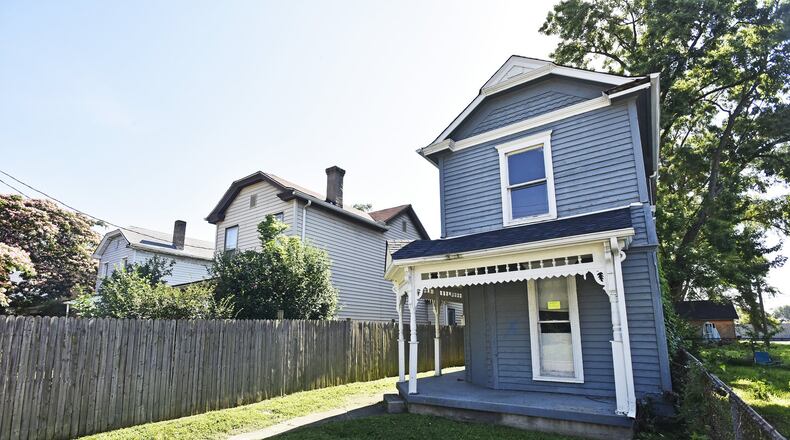The neighborhood revitalization projects would be similar to others in historic district development areas, such as Grafton Hills, South Park, Wright-Dunbar areas in Dayton, and the Over-the-Rhine district in Cincinnati.
The Oakland neighborhood, which has more than 1,000 structures, is bordered by First Avenue to the west of the Middletown Pioneer Cemetery; south from the cemetery on Richmond Street to Parkview Drive; north to Young Street, and west on Penfield Avenue around the former AK Steel headquarters property to Curtis Avenue, then north to Verity Parkway back to First Avenue.
City officials said the project would include more than 300 homes, corner retail stores, commercial businesses and several vacant lots and renovate Oakland Park at Baltimore Street and Fairmount Avenue. It would focus on redeveloping Oakland’s cultural assets, revitalizing historic housing, commercial pockets, and Carnegie Library, and create a Historic District to spur investment.
Jennifer Ekey, city economic development director, said the proposed redevelopment incentive district is projected to increase existing home valuations by more than 275 percent and pump a potential $10 million into the neighborhoods, resulting in an additional $1.2 million in potential city tax revenue.
She said the initiative would enable the city to pursue federal and state grants and Historic Tax Credits for restoring existing structures, addressing blight and streetscaping.
In addition, Oakland residents may be able to obtain low-interest improvement loans to foster owner-occupied pride to stay in their neighborhood and update their homes as part of the revitalization and renaissance.
The project will also provide new infill housing development opportunities in the Oakland neighborhood around the former Carnegie Library and former middle school site.
The developers and city officials are proposing new housing that could include new three-bedroom loft homes and three-to-four bedroom townhouses, condominiums and row-houses ranging from 1,500 to 2,400 square feet on the former middle school site, Mayzum said. The developers said they have been contacted by potential investors, developers and Oakland residents.
City officials said the former middle school site has been cleared and graded, however, the Middletown City School District has to wait for the state’s final sign-off on the new middle school construction before they can move on disposing of the property. That could happen between August and December.
Last year, Mayzum purchased the former 105-year-old Carnegie Library at 1320 First Ave. with plans to transform it into a cooperative brewing company, restaurant, reception hall and business incubator. It’s also envisioned as an anchor for the new historic district.
Planning Director Ashley Combs said the city Historic Commission voted June 20 to designate the Carnegie Library as a local historic landmark. City Council will hold a public hearing on the proposed designation on Aug. 6.
The city and the developers are also working to receive a Certified Local Government designation in order to access various state and federal programs expeditiously to spur investment and redevelopment.
“I am currently working with banks by responding to their questions and working towards finalizing and approving the construction loans for Carnegie Library Middletown,” Mayzum said. “As soon as the loans are approved, I anticipate the construction to take 18 to 24 months. My goal is to start mobilizing for construction as soon as the loans are approved.”
While he’s waiting for the construction loans to be approved, Mayzum said he’s ramping up for another volunteer work week, July 11-17 to help clean out some of the remaining debris in the building.
Last week, Mayzum came upon a house built in the 1880s in the 300-block of Garfield Street that was slated for demolition. He contacted city and Butler County Land Bank officials about purchasing the house for future redevelopment and prevent its demolition.
While Barton said the first phase was studying the feasibility of the project, the second phase of the project will be more “ground laying” such as creating the historic district and obtaining a nomination to the National Register.
“The biggest thing we need to do is get the Oakland district on the National Register,” he said. “It’s not preventing things from happening, but it’s a foundation. The National Register has incentives for the overall project.”
He said phase two funding would be used to create a downtown redevelopment district to provide low-interest buy-down loans for new owner-occupied housing, housing construction and streetscape plans, neighborhood outreach, securing the former middle school site, and designs for two gateways into the neighborhood.
“There’s still a fair amount of groundwork to do build new housing and we’re still identifying opportunity lots such as abandoned houses,” Barton said. “We need to update our information to determine future acquisitions for new development.”
Barton told council previously there were 112 to 140 lots available for infill construction and incentives, including subsidies for purchasers and subsidies could be available for exterior improvements. These subsidies would be awarded on a first come, first serve basis.
He also said establishing a neighborhood association would strengthen the social aspect and the neighborhood accountability. In addition, he said the existing houses would need to be redeveloped to a more modern design that today’s families will want to live in.
Barton said it’s also more cost effective to rehab existing homes than to construct new homes. He said new construction runs approximately $113 per square foot and rehab can be approximately $41-$75 per square foot depending on the tax credits. The rehabbed homes will feature new floor plans to be modern and open concept which will offer flexibility to homeowners.
About the Author

